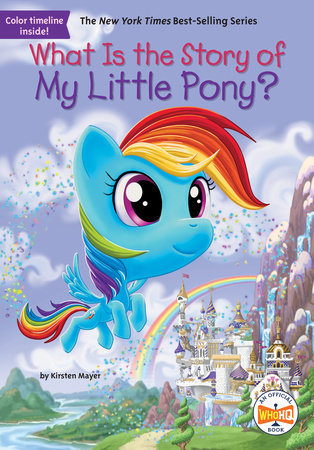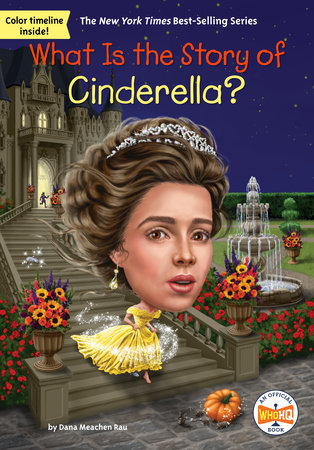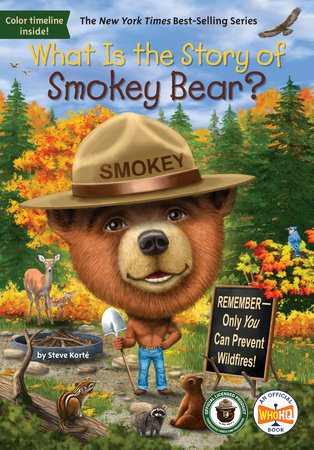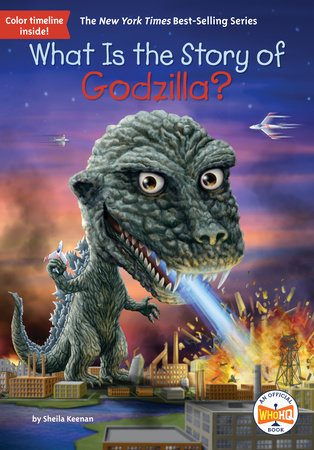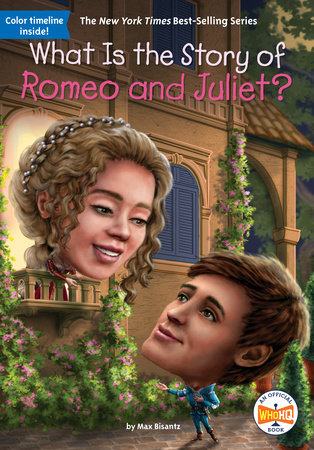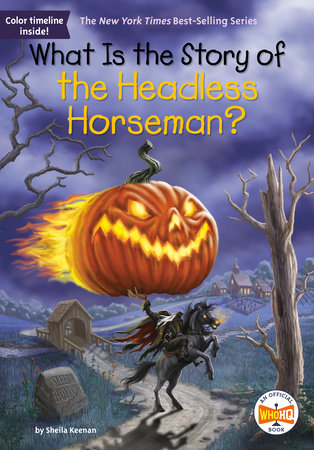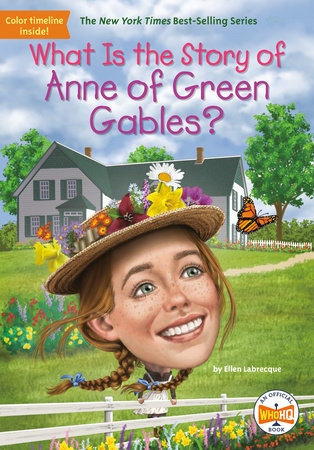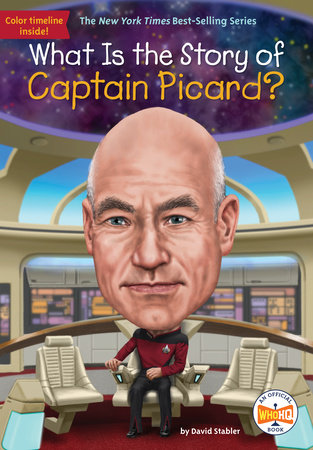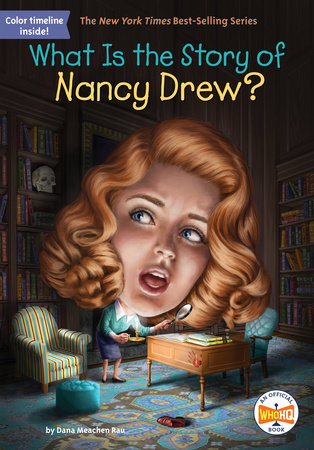Excerpt
What Is the Story of My Little Pony?
What Is the Story of My Little Pony? During 2019, there were over twenty conventions all over the world where fans gathered to celebrate their favorite cartoon show and its stars. Thousands of people celebrated together in cities all over the United States and Europe. Thailand, China, and even Australia hosted events and cruises. One event reached a record of ten thousand attendees! All these people, both grown--ups and kids, were fans of the animated television series My Little Pony: Friendship is Magic.
At the events, everyone could attend panels featuring the voice actors from the show and share handmade items such as plush ponies, sparkly nail polish, artwork, and more that were inspired by the animated series.
Many fans made their own costumes to dress up as their favorite character by wearing wigs, unicorn horns, and feathered wings. Some even made hooves to wear over their shoes! A few costumes weren’t meant to look like Pony characters, but were inspired by them, using certain colors and symbols such as moons and suns on fancy dresses and capes. Fans were able to show off their creativity and admire everyone else’s, too. In fact, one major appeal of these conventions was to simply meet each other, make new friends, and admire the costumes and crafts. Fans wanted to live up to the name of the show and extend friendship to their fellow fans.
For decades, My Little Pony has grown with each generation, reaching around the world and across all ages to build a fan base of millions. From the first little girls who played with them in the 1980s to children today, these classic characters continue to spread a magical message of friendship and empowerment.
Chapter 1 A Tale of Three Brothers My Little Pony figures are produced by a large toy company called Hasbro that also makes games, television shows, and films that are popular all over the world. The huge company it is today has come a long way from its small origins.
The Hassenfeld family immigrated to the United States from Poland. In 1923, brothers Herman, Hillel, and Henry Hassenfeld started a family company in Providence, Rhode Island. At first, they sold leftover fabric pieces, then started making and selling pencil cases and, eventually, the pencils to go inside them.
Three years later, Hillel left to do other things, and his brother Henry took charge of the Hassenfeld Brothers company with Herman. In the 1940s, Henry introduced some new products—-toys! Some of the first toys they sold were doctor and nurse playsets and modeling clay. Soon their toy business was bigger than the pencil business had been. Henry continued to expand not only by creating his own toy ideas, but also by buying ideas from people outside the company.
In 1952, the brothers had their first major hit with a toy called Mr. Potato Head. They had purchased rights to the toy from creator George Lerner. Unlike the modern plastic version, the original set included pieces that kids could push into a real potato. Mr. Potato Head was the first toy to be advertised on television.
The company created some of the toys, bought others from inventors, and grew bigger by buying other companies and their valuable toy and game products. As control passed to a new generation, with Henry’s son Merrill taking over, the company eventually became Hasbro, Inc. The Hasbro name is a combination of the two words Hassenfeld Brothers.
Hasbro’s next big hit was G.I. Joe action figures, first made in 1964. The soldier toys looked like members of the armed forces and were a success as a gift for young boys. Meanwhile, another toy company called Mattel had released one of the most popular toys of all time—-the Barbie doll. The team at Hasbro wanted a product to compete with that, a toy that young girls would love, something that would feel totally original. Where would that big idea come from?
Getting into Action In the 1960s, the word doll was used in the American toy industry to refer to baby dolls or fashion dolls, toys that were intended for girls. Children would pretend to parent the baby dolls and play dress--up with the fashion dolls. With the creation of G.I. Joe, toys that were soldiers, the Hasbro team wanted to both appeal to boys and indicate how they should be played with, and so a company executive created the term action figure in 1964. Other toys to be among the first action figures were Marvel and DC superhero figures, and toys made to go with the original Star Wars films. Then He--Man and Transformers toys hit the shelves in the 1980s. Still used today to describe certain toys, action figure was first applied to G.I. Joe! Chapter 2 A Pony Is Born How is a toy created? Sometimes one person invents and builds it. More often, a large team of people contributes to the process. Many companies have employees that are part of a research and development team. In a toy company, the team will brainstorm ideas, draw them, build a prototype—-or sample—-of the toy, and then test it to see if kids like playing with it. Hasbro’s team had several ideas they were working on, but one quickly rose to the top of the list.
It was called My Pretty Pony, and the company launched it in 1981. The hard plastic pony was ten inches tall and had mechanisms to swish its tail and wink its eye. The first one was brown. Then pink and yellow versions were released that had designs on the rumps. And then a set with one large pony and one small baby pony was sold. The pony had a long mane and tail that could be brushed and braided. The idea was that young children could play with this pony much like a fashion doll. My Pretty Pony came with a comb, brush, and other accessories.
Famous Horses Since the Middle Ages, when the hobbyhorse (a stick with a horse’s head at one end) was a popular toy, young people have loved horses and horse stories. Some of the most famous horses came from books.
Black Beauty by Anna Sewell, published in 1877, is one of the best--selling novels of all time. The realistic title character, an English horse that pulled cabs in London, has inspired several films and television series from the 1910s to today.
The 1940s brought a trio of successful horse books. The Misty of Chincoteague series of books was based on a real palomino pinto pony. The original books were written by Marguerite Henry, and more titles were published over the course of the next forty--five years. The wild horse in Walter Farley’s Black Stallion novel also became well--known, inspiring multiple books, films, and television series. My Friend Flicka, by Mary O’Hara, in which a boy trains a wild mustang, inspired radio, television programs, and films for over fifty years. While My Pretty Pony was successful, the team at Hasbro kept working on the idea to make it even better. They made the toy smaller, switched to a softer plastic, and decided to lean into fantasy with a variety of colors that aren’t seen on real-life horses. The different colors and the symbols on their rumps would make them collectible, so kids might want to own multiple ponies.
There have always been horse toys and horse stories, but when these colorful ponies came on the scene, they did something different: these weren’t realistic horses or realistic stories. These were fantastical creatures living in their own magical world. The choice to move this toy from reality to fantasy was a big deal at the time. Many of the most successful toys had been modeled on children using them to pretend to be adults by role-playing parenting, cooking, working, and dressing up. Kenner’s Baby Alive, Mattel’s Barbie dolls, and the still-popular Easy Bake Oven were all playthings based on real-life actions that kids saw adults doing. Even G.I. Joe outfits were based on real armed services uniforms and playing with them mimicked an adult military life. Toy trains and cars were similarly based in reality.
Because of that, the revised pony toys were a risk. They invited kids to imagine a unique fantasy world while playing with them. Yet the team at Hasbro thought they had the right idea. They released the new line of six smaller, softer, colorful ponies in 1983 under a new name, My Little Pony.
The first six My Little Pony toys were not only new colors—they also had names. They were called Cotton Candy, Blossom, Butterscotch, Minty, Blue Belle, and Snuzzle. As the toy line expanded with playsets, ponies in new poses, and clothes, it grew to eventually include over three hundred different ponies. Toys in this first style, sold until 1992, are referred to as Generation 1.
How Do They Make a Pony? There are a few different processes for producing plastic toys, but these are the steps for the latest ponies on the shelves.
1. A designer sketches what the toy could look like from multiple angles, including colors and accessories. The rest of the team gives notes, and the sketch is refined. 2. Then a sculptor digitally creates a computer “toy sculpt” to bring the design into three dimensions. (Before computers, this step would be hand sculpted in clay!) 3. The placement of the paint for the pony’s features and the color for the hair is finalized. One sample pony gets paint applied and hair attached to the head. A stylist determines the final look for the mane and tail. This sample is kept as the guideline for the ponies that will be produced. 4. An engineering team determines how parts will move and where joints will go, making sure the toy meets safety standards. 5. Packaging and graphics are designed so that the package looks good and the pony can be shipped safely. 6. The ponies are assembled and shipped all over the world to their forever homes! The 1983 launch of My Little Pony was an instant global hit, and Hasbro rode the success of Generation 1 for almost ten years, expanding the toy line each year. The ponies were sold around the world, and were also manufactured in over a dozen countries with special versions in each place. Ponies could be found in stores from South Africa to Macau, from Peru to Scandinavia, from Australia to India. They even made some Pony Friends. Hasbro released a giraffe, an elephant, a llama, a lion, a camel, a moose, and even a dinosaur.
Where would Hasbro and the ponies go from here?


